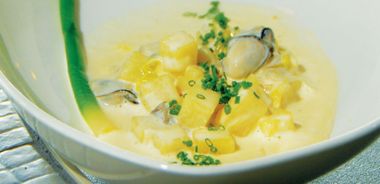Pacific Oyster and Leek Stew

While oysters are revered as aphrodisiacs, less well known are their health benefits: low in fat and high in protein, B12, and iron, there are many reasons to love this stew.
3 Tbsp (45 mL) unsalted butter
1/3 cup (80 mL) shallots, sliced
1 1/2 cups (350 mL) potatoes, diced and rinsed
3/4 cup (180 mL) leeks, sliced (no dark green)
3 cups (750 ml) 35% cream
Pinch nutmeg
Salt and pepper
1/2 cup (125 mL) white wine
1/2 cup (125 mL) vermouth
24 oysters, freshly shucked, reserve nectar
Melt butter in a heavy-bottomed pot over medium-high heat. Add shallots, potatoes, and leeks and sweat for 5 minutes without adding any colour. Pour in cream; season with nutmeg, salt, and pepper. Simmer for 10 minutes or until potatoes are tender.
Pour white wine and vermouth into a pot and bring to a boil.
Note: Use caution if using gas as the wine and vermouth may flamb?without a flame the mixture won’t ignite.
Shuck oysters into a container and then pour nectar and all into the simmering wine and vermouth. Remove from heat and, with a slotted spoon, remove the slightly poached oysters from the liquid. Place liquid back on the stove and reduce by half.
Strain this liquid into the potato, leek, and cream mixture and bring it all back to a simmer. Adjust the seasoning and remove from heat. Warm the oysters back up by placing them into the hot cream and divide evenly into 6 hot bowls.
Serves 6.
source: "Something Nu for Fall", alive #299, September 2007




